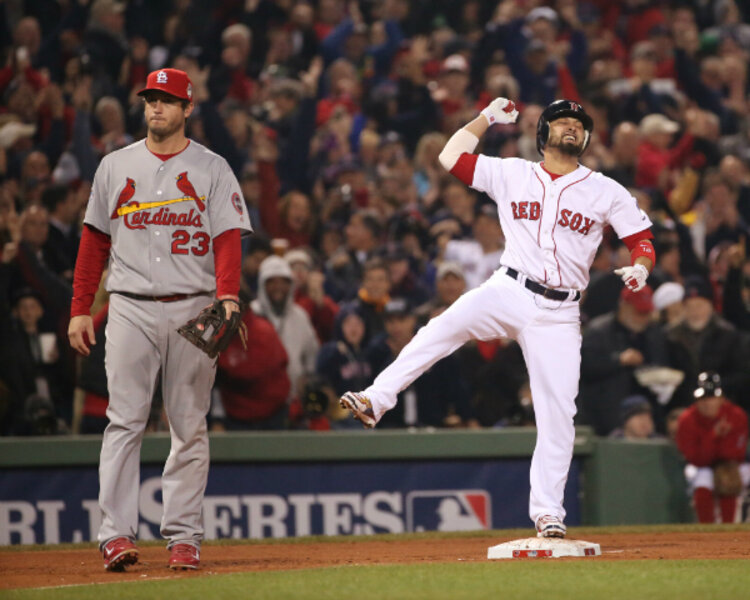Red Sox and Cardinals: World Series tango part of two-city sports serial
Loading...
| BOSTON
Anyone who thought Boston’s Wednesday night World Series triumph ended St. Louis’s sports misery in Beantown better get out of town fast. That’s because on Friday, just two days after the Red Sox’ 4-2 Series victory over the Cardinals, the Hub will honor Bill Russell, the player who led the Celtics to 11 NBA championships but was originally drafted by the old St. Louis Hawks.
The sports fortunes of these two cities are more intertwined than many may imagine, and historically the euphoria in one has meant heartache for the other.
Yes, these communities may be a study in contrasts. St. Louis has its gleaming archway, barges, catfish, and Panera Bread, Boston its Old North Church, sailboats, scrod, and Dunkin’ Donuts. But when it comes to sports, they’ve been joined at the hip.
Their shared sporting melodramas date to the 1946 World Series, the first played in the postwar era, when the Cardinals and Red Sox met as stars like Ted Williams, Stan Musial, and Bobby Doerr were back in baseball flannels after time away serving in the military. The Cardinals clawed their way into the Series for the fourth time in five years by beating the Dodgers in the first-ever pennant playoff. The Red Sox were making their first World Series appearance since their 1918 championship.
The Series went seven games, and was decided by one of the most memorable plays in Series history: Enos Slaughter’s “Mad Dash” from first base to score the winning run for St. Louis in the eighth inning. Johnny Pesky hesitated ever so slightly in relaying the throw from the outfield. The relay failed to nail Slaughter at home plate.
The tale of the two sports cities wrote its next chapter during the 1956 National Basketball Association draft, when the Celtics acquired Russell in the most storied trade in league history. St. Louis was a contending team that managed to add native son Ed Macauley and Cliff Hagen, two future Hall of Famers to its roster, in exchange for rookie Bill Russell, who the Hawks selected with the draft’s second overall pick.
Russell became the centerpiece of Boston’s dynasty, which included an incredible eight titles in a row.
But the Hawks did not fade away. In fact, for several years they were the virtual equals of the Celtics. The two teams met in the league finals four times between 1957 and 1961, going to a seventh game twice, with Boston winning both times. In the first of these, the deciding game went to double overtime, with Boston, squeezing out a 125-123 win.
Russell anchored the dynasty by gobbling up rebounds, playing tenacious defense, and providing whatever offensive production was needed in the team’s balanced scoring attack. Friday, Boston will finally get around to paying Russell the ultimate compliment by unveiling a statue of him downtown.
Ironically, the Hawks felt compelled to move out of St. Louis in 1965 when their owner, Ben Kerner, wanted a new arena and relocated the franchise to Atlanta. The very next year, the baseball Braves, who had begun in Boston, also moved to Atlanta.
The next time the two cities engaged in an athletic summit was during the 1967 World Series, when just as this season, the Red Sox rebounded from a terrible record the year before. The “Impossible Dream” Red Sox of Carl Yastrzemski and Jim Lonborg, however, fell just short in the World Series, losing in seven games to the Cardinals, whose pitching ace Bob Gibson was credited with three wins.
The St. Louis-Boston rivalry shifted onto ice in 1970, when the Bobby Orr-led Boston Bruins and the St. Louis Blues, who were making their third straight appearance in the Stanley Cup finals, did battle. Boston, which hadn’t won the Cup since 1941, swept a one-sided series that nonetheless produced a memorable ending, with Orr scoring the decisive goal 40 seconds into overtime. A classic photograph snapped at the instant of victory shows a tripped Orr raising his stick in celebration as he flies headlong in front of the goal.
The two-city sports showdowns returned the diamond in 2004, when the Red Sox ended their 86-year championship drought by sweeping the Cardinals in the World Series. That triumph, however, was largely overshadowed by Boston’s historic back-from-the dead comeback from an 0-3 deficit to beat the Yankees in the American League Championship Series.
This year, the Cardinal-Red Sox reunion provided Boston with the opportunity to cap its first championship in Fenway Park since 1918. The saddened Cardinals watched the celebration with long faces while wearing jerseys with a No. 6 patch that paid tribute to Musial, who died earlier this year. That small reminder of the 1946 St. Louis triumph was no consolation, however.





